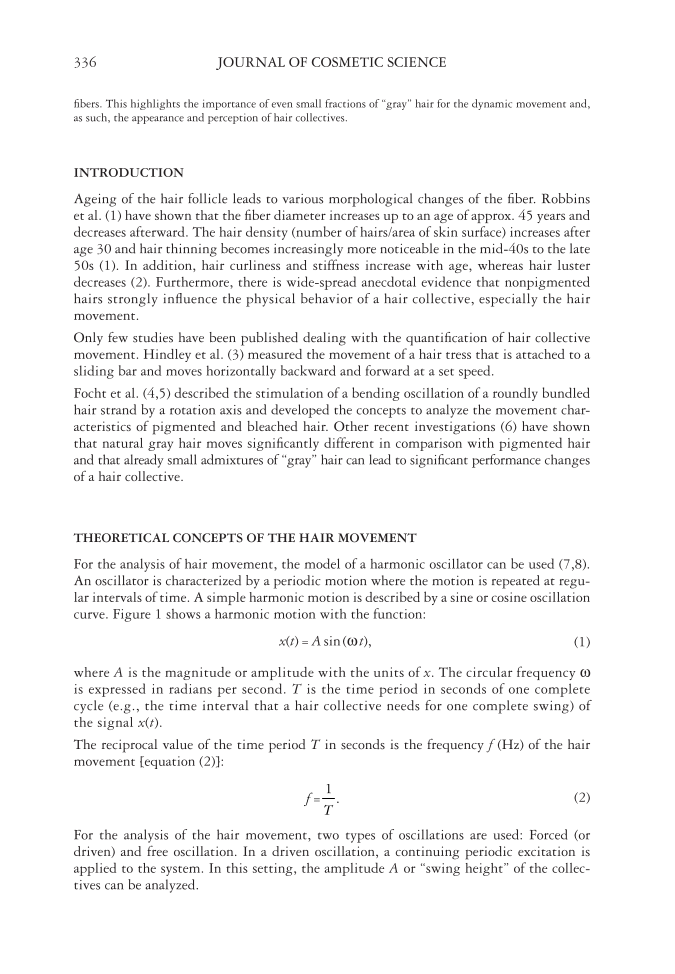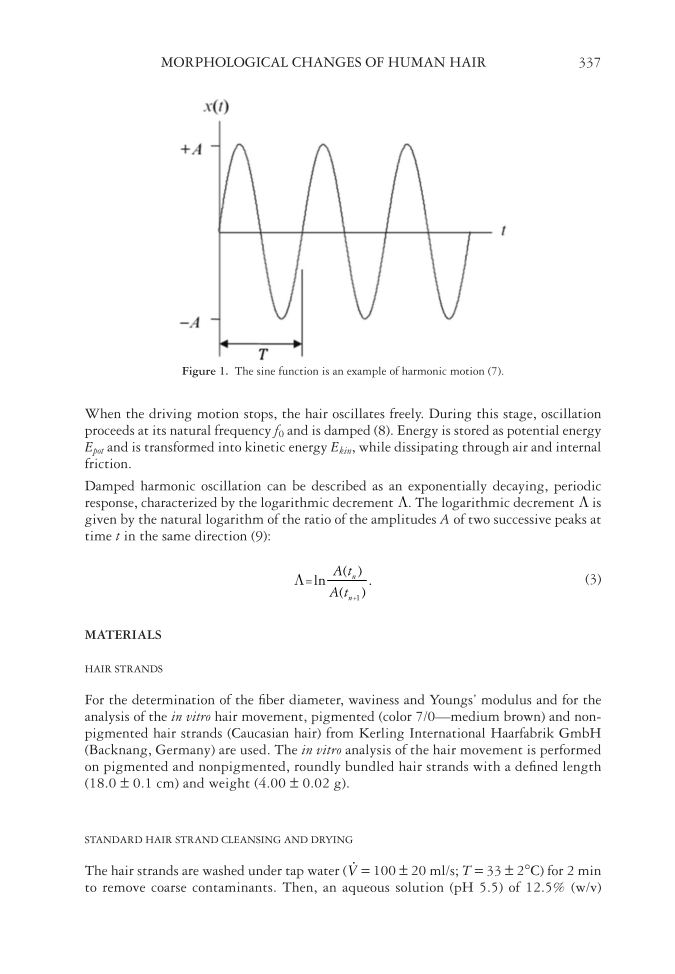JOURNAL OF COSMETIC SCIENCE 336 fi bers. This highlights the importance of even small fractions of “gray” hair for the dynamic movement and, as such, the appearance and perception of hair collectives. INTRODUCTION Ageing of the hair follicle leads to various morphological changes of the fi ber. Robbins et al. (1) have shown that the fi ber diameter increases up to an age of approx. 45 years and decreases afterward. The hair density (number of hairs/area of skin surface) increases after age 30 and hair thinning becomes increasingly more noticeable in the mid-40s to the late 50s (1). In addition, hair curliness and stiffness increase with age, whereas hair luster decreases (2). Furthermore, there is wide-spread anecdotal evidence that nonpigmented hairs strongly infl uence the physical behavior of a hair collective, especially the hair movement. Only few studies have been published dealing with the quantifi cation of hair collective movement. Hindley et al. (3) measured the movement of a hair tress that is attached to a sliding bar and moves horizontally backward and forward at a set speed. Focht et al. (4,5) described the stimulation of a bending oscillation of a roundly bundled hair strand by a rotation axis and developed the concepts to analyze the movement char- acteristics of pigmented and bleached hair. Other recent investigations (6) have shown that natural gray hair moves signifi cantly different in comparison with pigmented hair and that already small admixtures of “gray” hair can lead to signifi cant performance changes of a hair collective. THEORETICAL CONCEPTS OF THE HAIR MOVEMENT For the analysis of hair movement, the model of a harmonic oscillator can be used (7,8). An oscillator is characterized by a periodic motion where the motion is repeated at regu- lar intervals of time. A simple harmonic motion is described by a sine or cosine oscillation curve. Figure 1 shows a harmonic motion with the function: x(t)=Asin(ωt), (1) where A is the magnitude or amplitude with the units of x. The circular frequency ω is expressed in radians per second. T is the time period in seconds of one complete cycle (e.g., the time interval that a hair collective needs for one complete swing) of the signal x(t). The reciprocal value of the time period T in seconds is the frequency f (Hz) of the hair movement [equation (2)]: 1 = . f T (2) Fo r the analysis of the hair movement, two types of oscillations are used: Forced (or driven) and free oscillation. In a driven oscillation, a continuing periodic excitation is applied to the system. In this setting, the amplitude A or “swing height” of the collec- tives can be analyzed.
MORPHOLOGICAL CHANGES OF HUMAN HAIR 337 When the driving motion stops, the hair oscillates freely. During this stage, oscillation proceeds at its natural frequency f0 and is damped (8). Energy is stored as potential energy Epot and is transformed into kinetic energy Ekin, while dissipating through air and internal friction. Damped harmonic oscillation can be described as an exponentially decaying, periodic response, characterized by the logarithmic decrement -. The logarithmic decrement - is given by the natural logarithm of the ratio of the amplitudes A of two successive peaks at time t in the same direction (9): -=ln ( ) . ( ) n n+1 A t A t (3) MATER IALS HAIR STRANDS For the determination of the fi ber diameter, waviness and Youngs’ modulus and for the analysis of the in vitro hair movement, pigmented (color 7/0—medium brown) and non- pigmented hair strands (Caucasian hair) from Kerling International Haarfabrik GmbH (Backnang, Germany) are used. The in vitro analysis of the hair movement is performed on pigmented and nonpigmented, roundly bundled hair strands with a defi ned length (18.0 ± 0.1 cm) and weight (4.00 ± 0.02 g). STANDARD HAIR STRAND CLEANSING AND DRYING The hair strands are washed under tap water (V = 100 ± 20 ml/s T = 33 ± 2°C) for 2 min to remove coarse contaminants. Then, an aqueous solution (pH 5.5) of 12.5% (w/v) Figure 1. The sine function is an example of harmonic motion (7).
Purchased for the exclusive use of nofirst nolast (unknown) From: SCC Media Library & Resource Center (library.scconline.org)









































































































